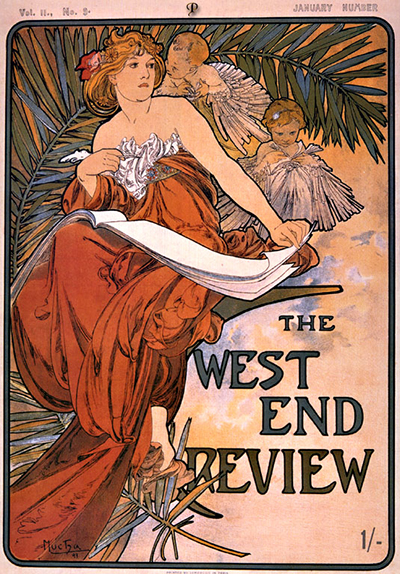This delightful illustration was produced by Alphonse Mucha in 1897, and it would be used as the cover for British literary magazine The West End Review.
The artist puts the title for this piece down in the right lower corner, and allows the rest of the composition to be used for a female figure to dominate. A young woman in long red dress is accompanied by two young girls who sits patiently behind her. The clothing for them all is glamorous and classical, though the artist does not go into quite as much detail for this piece as he does in other cover designs from his career. The price for each magazine is listed in the bottom right, just inside the curved boundary which covers the full perimeter. On its outside in the top hand side are some small details regarding the date of this particular publication. The magazine was a British commentary on the interests of those in high society and Mucha's work was ideally suited to serve as its cover.
The background is made up of a bright sky in tones of pink and blue, with an exotic plant spread across the left hand side of the drawing. This delivers strong tones of blue and green through the alternating leaves which wrap around the back of the three figures. There is also aesthetic interest in the rolls of the woman's dress which is deliberately extended beyond what would be in anyway practical. She also has an elongated notepad on her lap which perhaps links to the magazine that this design is advertising - perhaps suggesting that this highly desirable woman who is very much a part of high society also happens to be a big fan of the The West End Review. Many of the advertising pieces designed by Mucha were all about selling a lifestyle, and then connecting the particular products to it.
Mucha had started producing book illustrations several years earlier and by now was starting to build a strong reputation within several different industries. Many patrons would call on his services several times and found that his work could help them increase sales considerably, with no television advertising available at this time. His classical style remained consistent throughout, partly due to the companies requesting the same look each time, even though he may have desired a new direction after a while. He was very much a commercial illustrator and needed to keep these companies onside in order to protect his future income.




